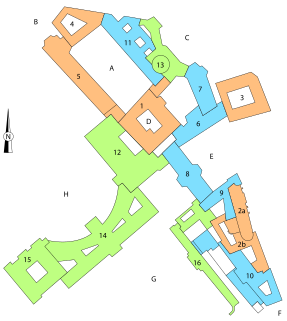
The Hofburg is the former principal imperial palace of the Habsburg dynasty. Located in the center of Vienna, it was built in the 13th century and expanded several times afterwards. It also served as the imperial winter residence, as Schönbrunn Palace was the summer residence. Since 1946 it is the official residence and workplace of the President of Austria.

Palais Rothschild refers to a number of palaces in Vienna, Austria, which were owned by members of the Austrian branch of the Rothschild banking family. Apart from their sheer size and elegance, they were famous for the huge collections of valuable paintings, statues, furniture, books, and armour that they housed, another reflection of the family's vast wealth and prominent position.

The Palais Lanckoroński was a palace in Vienna, Austria, located at Jacquingasse 16-18, in the Landstraße District. It was constructed in 1894-95 for Count Karol Lanckoroński and his family as a personal residence, and it housed the count's enormous art collection. The palace was built in a neo-baroque style by the theatre architects Ferdinand Fellner and Hermann Helmer. The building was three stories high, set back from the street, and protected by a wall with double gates. The entrance hall was wood panelled, two stories high, and decorated with portraits of the family. Other festive halls were decorated with frescoes and luxurious gobelin tapestries from the 17th century. Precious paintings, furniture and sculpture from different eras were arranged to form themed ensembles in the various rooms, with the rooms named to reflect the collection housed within. The palace was severely damaged in World War II, and was torn down in the 1960s.
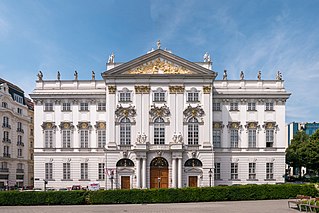
Palais Trautson is a Baroque palace in Vienna, Austria, located at Museumstraße 7. It was once owned by the noble Trautson family.

Palais Augarten is a Baroque palace in the district of Leopoldstadt, Vienna, Austria. Constructed in the late seventeenth century by Johann Bernhard Fischer von Erlach on the site of a hunting château and gardens, the palace and gardens were expanded in the nineteenth century under Emperor Franz Joseph I of Austria. Despite extensive damage suffered during World War II, the palace has been maintained almost in its original appearance, and many of the original furnishings can still be found there. Today, Palais Augarten is the home and rehearsal space of the Vienna Boys' Choir, who also have their own school there. The palace is located in the 130-acre Augarten park, which is the oldest Baroque garden in Vienna.

Palais Lobkowitz, or Palais Dietrichstein-Lobkowitz, is a Baroque palace in Vienna, Austria. It was owned by the noble Lobkowitz family.
Palais Liechtenstein may refer to:
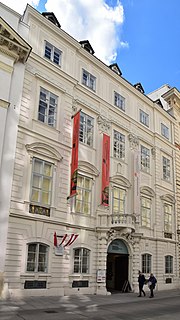
Palais Mollard-Clary is a Baroque palace in Vienna, Austria. It is located in the first district Innere Stadt, at Herrengasse 9.

Palais Pallavicini is a palace in Vienna, Austria. It is located in the Josefsplatz square at number 5. It has been owned by the noble Pallavicini family. It was previously built and owned by the Fries banking family and is therefore also known as Palais Fries.

Palais Kinsky is a Baroque palace in central Vienna, Austria. It was originally built for Count Wirich Philipp von Daun, the garrison commander whose son Leopold became a Field Marshal of Empress Maria Theresa. The palace was later bought by the Kinsky family of Bohemia, and it is sometimes called the Palais Daun-Kinsky.
The Herrengasse is a street in Vienna, located in the first district Innere Stadt.

The Freyung is a triangular public square in Vienna, located in the Innere Stadt first district of the city.

Ballhausplatz is a square in central Vienna containing the building that for over two hundred years has been the official residence of the most senior Austrian Cabinet Minister, the State Chancellor, today the Chancellor of Austria. As a result, Ballhausplatz is often used as shorthand for the Austrian Federal Chancellery. Until 1918 the Foreign Ministry of Austria-Hungary was also housed here. Similar to Downing Street or the Hotel Matignon, the word Ballhausplatz is a synecdoche for the seat of power.

The Royal Palace of Brussels is the official palace of the King and Queen of the Belgians in the centre of the nation's capital Brussels. However it is not used as a royal residence, as the king and his family live in the Royal Palace of Laeken on the outskirts of Brussels. The website of the Belgian Monarchy describes the function of the palace as follows:
The Palace is where His Majesty the King exercises his prerogatives as Head of State, grants audiences and deals with affairs of state. Apart from the offices of the King and the Queen, the Royal Palace houses the services of the Grand Marshal of the Court, the King's Head of Cabinet, the Head of the King's Military Household and the Intendant of the King's Civil List. The Palace also includes the State Rooms where large receptions are held, as well as the apartments provided for foreign Heads of State during official visits.

The Augarten is a public park of 52.2 hectares situated in the Leopoldstadt, the second district of Vienna, Austria. It contains the city's oldest Baroque park.

The Palais Albert Rothschild was a palatial residence in Vienna, Austria. It was one of five Palais Rothschild in the city that were owned by members of the Rothschild banking family of Austria, a branch of the international Rothschild family. It was located at Heugasse 26, in the 4th (Wieden) district of Vienna. Commissioned by Baron Albert von Rothschild, it was designed and built by the French architect Gabriel-Hippolyte Destailleur between 1876 and 1884, and demolished in 1954.

Palais Porcia is a former urban residence in the western quarter of the Innere Stadt of Vienna, Austria. It stands at 23, Herrengasse between Palais Kinsky and Palais Trautmansdorff and across Palais Harrach. The palace was built in 1546 for the descendants of Count Gabriel von Salamanca-Ortenburg. It was representative of the simple Renaissance style that emerged in Vienna in the middle of the 16th century. In the 17th and later centuries it was extensively remodelled in Baroque and Rococo styles but the inner court still contains an early Renaissance arcade. As of 2010, Palais Porcia houses the Administrative Library of the Austrian Federal Chancellery.

The Palais Equitable is a mansion in Stock-im-Eisen-Platz in the Innere Stadt of Vienna, Austria, that was built in the 19th century for The Equitable Life Assurance Society of the United States and that incorporates the Stock im Eisen on one corner.
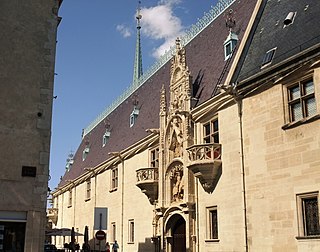
The Ducal Palace of Nancy is a former princely residence in Nancy, France, which was home to the Dukes of Lorraine. It houses the Musée Lorrain, one of Nancy's principal museums, dedicated to the art, history and popular traditions of Lorraine until the early 20th century. It has been listed since 1840 as a monument historique by the French Ministry of Culture.
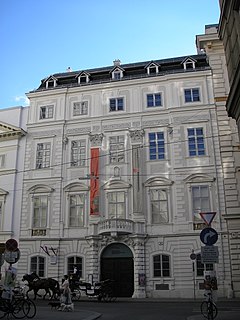
The Globe Museum is a museum in the Palais Mollard, Vienna, Austria, part of the Austrian National Library. It was opened in 1956, and is the only public museum in the world devoted to globes, being three-dimensional models of Earth or other celestial bodies, or spherical representations of the celestial sphere.

















